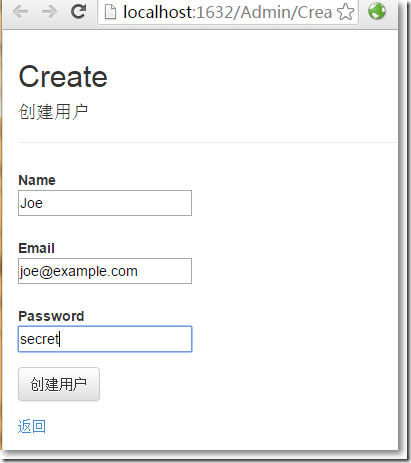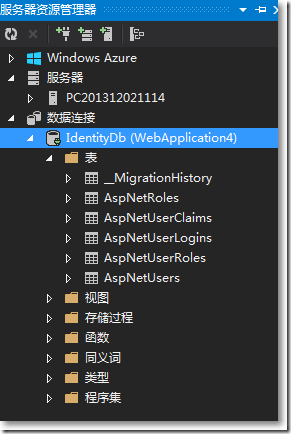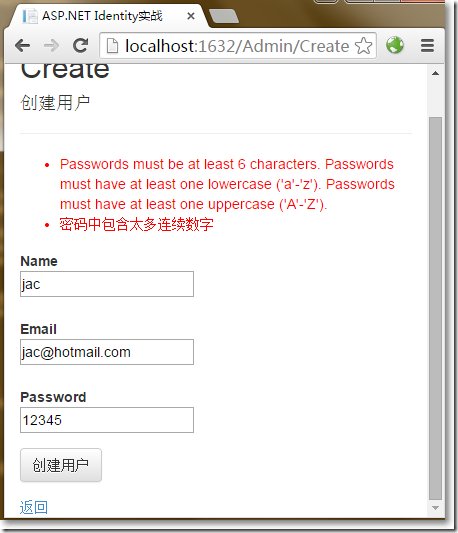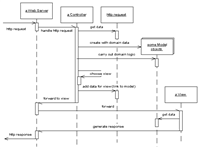源码在这里:https://github.com/darrenji/useidentitycruduserinmvc,本地下载
在vs2013中创建一个mvc项目,用默认的"无身份验证"作为身份验证机制。
通过控制台下载bootstrap。
install-package -version 3.0.3 bootstrap
下载成功后,在解决方案下的content和scripts多了该版本的css和js文件。
把创建项目默认homecontroller中的所有action以及/views/home下的所有视图删除。
热热身
先来做一个简单练习。
在homecontroller中的index方法中,把一个字典传递给视图。
public class homecontroller : controller
{
public actionresult index()
{
dictionary<string, object> data = new dictionary<string, object>();
data.add("placeholder", "placeholder");
return view(data);
}
}_layout.cshtml设置如下:
<head>
<meta http-equiv="content-type" content="text/html; charset=utf-8"/>
<meta charset="utf-8" />
<meta name="viewport" content="width=device-width, initial-scale=1.0">
<title>asp.net identity实战</title>
<link href="~/content/bootstrap.min.css" rel="external nofollow" rel="stylesheet" />
<link href="~/content/bootstrap-theme.min.css" rel="external nofollow" rel="stylesheet" />
<style>
.container {padding-top:10px;}
.validation-summary-errors{color:red;}
</style>
</head>
<body>
<div class="container">
@renderbody()
</div>
@scripts.render("~/bundles/jquery")
@scripts.render("~/bundles/bootstrap")
@rendersection("scripts", required: false)
</body>home/index.cshtml视图中:
@{
viewbag.title = "index";
layout = "~/views/shared/_layout.cshtml";
}
<div class="panel panel-primary">
<div class="panel-heading">用户明细</div>
<table class="table table-striped">
@foreach (string key in model.keys)
{
<tr>
<th>@key</th>
<td>@model[key]</td>
</tr>
}
</table>
</div>
前期准备
分别安装如下组件。
install-package microsoft.aspnet.identity.entityframework –version 2.0.0
install-package microsoft.aspnet.identity.owin -version 2.0.0
install-package microsoft.owin.host.systemweb -version 2.1.0
配置web.config如下:
<?xml version="1.0" encoding="utf-8"?>
<!--
有关如何配置 asp.net 应用程序的详细信息,请访问
http://go.microsoft.com/fwlink/?linkid=301880
-->
<configuration>
<configsections>
<!-- for more information on entity framework configuration, visit http://go.microsoft.com/fwlink/?linkid=237468 -->
<section name="entityframework" type="system.data.entity.internal.configfile.entityframeworksection, entityframework, version=6.0.0.0, culture=neutral, publickeytoken=b77a5c561934e089" requirepermission="false" />
</configsections>
<connectionstrings>
<add name="identitydb" providername="system.data.sqlclient" connectionstring="data source=(localdb)\v11.0;initial catalog=identitydb;integrated security=true;connect timeout=15;encrypt=false;trustservercertificate=false;multipleactiveresultsets=true"/>
</connectionstrings>
<appsettings>
<add key="webpages:version" value="3.0.0.0" />
<add key="webpages:enabled" value="false" />
<add key="clientvalidationenabled" value="true" />
<add key="unobtrusivejavascriptenabled" value="true" />
<add key="owin:appstartup" value="webapplication4.identityconfig" />
</appsettings>
<system.web>
<compilation debug="true" targetframework="4.5" />
<httpruntime targetframework="4.5" />
</system.web>
<runtime>
<assemblybinding xmlns="urn:schemas-microsoft-com:asm.v1">
<dependentassembly>
<assemblyidentity name="system.web.helpers" publickeytoken="31bf3856ad364e35" />
<bindingredirect oldversion="1.0.0.0-3.0.0.0" newversion="3.0.0.0" />
</dependentassembly>
<dependentassembly>
<assemblyidentity name="system.web.mvc" publickeytoken="31bf3856ad364e35" />
<bindingredirect oldversion="1.0.0.0-5.0.0.0" newversion="5.0.0.0" />
</dependentassembly>
<dependentassembly>
<assemblyidentity name="system.web.optimization" publickeytoken="31bf3856ad364e35" />
<bindingredirect oldversion="1.0.0.0-1.1.0.0" newversion="1.1.0.0" />
</dependentassembly>
<dependentassembly>
<assemblyidentity name="system.web.webpages" publickeytoken="31bf3856ad364e35" />
<bindingredirect oldversion="1.0.0.0-3.0.0.0" newversion="3.0.0.0" />
</dependentassembly>
<dependentassembly>
<assemblyidentity name="webgrease" publickeytoken="31bf3856ad364e35" />
<bindingredirect oldversion="0.0.0.0-1.5.2.14234" newversion="1.5.2.14234" />
</dependentassembly>
</assemblybinding>
</runtime>
<entityframework>
<defaultconnectionfactory type="system.data.entity.infrastructure.sqlconnectionfactory, entityframework" />
<providers>
<provider invariantname="system.data.sqlclient" type="system.data.entity.sqlserver.sqlproviderservices, entityframework.sqlserver" />
</providers>
</entityframework>
</configuration>以上,
- 增加了connectionstrings节点,将自动创建localdb数据库
- 在appsettings节点中增加了一个key为owin:appstartup项,这是确保owin运行正常的全局配置
在models文件夹下创建如下类。
public class appuser : identityuser
{
}在解决方案下创建infrastructure文件夹。
在infrastructure文件夹下创建一个上下文类,需要实现identitydbcontext<>接口。
public class appidentitydbcontext : identitydbcontext<appuser>
{
public appidentitydbcontext()
: base("identitydb")
{
}
static appidentitydbcontext()
{
//使用ef code first第一次创建的时候调用
database.setinitializer<appidentitydbcontext>(new identitydbinit());
}
public static appidentitydbcontext create()
{
return new appidentitydbcontext();
}
}
//初始化
public class identitydbinit : dropcreatedatabaseifmodelchanges<appidentitydbcontext>
{
protected override void seed(appidentitydbcontext context)
{
performinitialsetup(context);
base.seed(context);
}
//初始化工作
public void performinitialsetup(appidentitydbcontext context)
{ }
}在infrastructure文件夹下创建一个管理用户的类,需要继承usermanager<appuser>类。
还记得,先前在appsettings节点中配置了一个如下方式:
<add key="owin:appstartup" value="webapplication4.identityconfig" />
owin需要一个全局启动文件,默认会到项目的顶级命名空间下找identityconfig这个类。
那就在app_start中创建identityconfig这个类,这个类在webapplication4这个命名空间下。
namespace webapplication4
{
public class identityconfig
{
public void configuration(iappbuilder app)
{
app.createperowincontext<appidentitydbcontext>(appidentitydbcontext.create);
app.createperowincontext<appusermanager>(appusermanager.create);
app.usecookieauthentication(new cookieauthenticationoptions {
authenticationtype = defaultauthenticationtypes.applicationcookie,
loginpath = new microsoft.owin.pathstring("/account/login")
});
}
}
}显示用户
创建admincontroller,现在可以向视图传递所有的用户了,编写如下:
public class admincontroller : controller
{
public actionresult index()
{
return view(usermanager.users);
}
private appusermanager usermanager
{
get
{
return httpcontext.getowincontext().getusermanager<appusermanager>();
}
}
}再创建admin/index.cshtml类型为ienumerable<appuser>的强类型视图。
@model ienumerable<webapplication4.models.appuser>
@{
viewbag.title = "index";
layout = "~/views/shared/_layout.cshtml";
}
<div class="panel panel-primary">
<div class="panel-heading">
所有用户账户
</div>
<table class="table table-striped">
<tr><th>id</th><th>name</th><th>email</th><th></th></tr>
@if (model.count() == 0)
{
<tr><td colspan="4" class="text-center">还没有创建用户</td></tr>
}
else
{
foreach (webapplication4.models.appuser user in model)
{
<tr>
<td>@user.id</td>
<td>@user.username</td>
<td>@user.email</td>
<td>
@using (html.beginform("delete", "admin",
new { id = user.id }))
{
@html.actionlink("编辑", "edit", new { id = user.id },
new { @class = "btn btn-primary btn-xs" })
<button class="btn btn-danger btn-xs"
type="submit">
删除
</button>
}
</td>
</tr>
}
}
</table>
</div>
@html.actionlink("创建用户", "create", null, new { @class = "btn btn-primary" })
创建用户
在models文件夹下创建一个视图模型。
namespace webapplication4.models
{
public class createmodel
{
public string id { get; set; }
[required]
public string name { get; set; }
[required]
public string email { get; set; }
[required]
public string password { get; set; }
}
}在admincontroller中添加创建用户相关的方法。
public class admincontroller : controller
{
public actionresult index()
{
return view(usermanager.users);
}
//创建显示
public actionresult create()
{
return view();
}
[httppost]
public async task<actionresult> create(createmodel model)
{
if(modelstate.isvalid)
{
var user = new appuser{username = model.name, email = model.email};
identityresult result = await usermanager.createasync(user, model.password);
if(result.succeeded)
{
return redirecttoaction("index");
}else{
adderrorsfromresult(result);
}
}
return view(model);
}
//创建接收
private void adderrorsfromresult(identityresult result)
{
foreach(var error in result.errors)
{
modelstate.addmodelerror("", error);
}
}
private appusermanager usermanager
{
get
{
return httpcontext.getowincontext().getusermanager<appusermanager>();
}
}
}在admin/create.cshtml视图页中:
@model webapplication4.models.createmodel
@{
viewbag.title = "create";
layout = "~/views/shared/_layout.cshtml";
}
<h2>create</h2>
@using (html.beginform())
{
@html.antiforgerytoken()
<div class="form-horizontal">
<h4>创建用户</h4>
<hr />
@html.validationsummary(true)
<div class="form-group">
@html.labelfor(model => model.name, new { @class = "control-label col-md-2" })
<div class="col-md-10">
@html.editorfor(model => model.name)
@html.validationmessagefor(model => model.name)
</div>
</div>
<div class="form-group">
@html.labelfor(model => model.email, new { @class = "control-label col-md-2" })
<div class="col-md-10">
@html.editorfor(model => model.email)
@html.validationmessagefor(model => model.email)
</div>
</div>
<div class="form-group">
@html.labelfor(model => model.password, new { @class = "control-label col-md-2" })
<div class="col-md-10">
@html.editorfor(model => model.password)
@html.validationmessagefor(model => model.password)
</div>
</div>
<div class="form-group">
<div class="col-md-offset-2 col-md-10">
<input type="submit" value="创建用户" class="btn btn-default" />
</div>
</div>
</div>
}
<div>
@html.actionlink("返回", "index")
</div>
点击"创建"按钮,创建成功返回显示用户页面。

oh, my god,只是配置了一下就有数据了? 数据在哪呢?
点击左上角的"服务器资源管理器",右键"identitydb",点击"刷新"。

再打开aspnetusers表,刚创建的用户赫然在列。

好像还有点欠缺,用户输入密码的时候,总应该有些限制吧。
能想到的,asp.net identity都为我们准备好了。有一个passwordvalidator类就是干这个的。
在infrastructure文件夹中创建一个passwordvalidator类的继承子类。
namespace webapplication4.infrastructure
{
public class custompasswordvalidator : passwordvalidator
{
public override async task<identityresult> validateasync(string pass)
{
identityresult result = await base.validateasync(pass);
if (pass.contains("12345"))
{
var errors = result.errors.tolist();
errors.add("密码中包含太多连续数字");
result = new identityresult(errors);
}
return result;
}
}
}然后需要把这个规则告诉usermanager。
namespace webapplication4.infrastructure
{
public class appusermanager : usermanager<appuser>
{
public appusermanager(iuserstore<appuser> store) : base(store) { }
public static appusermanager create(identityfactoryoptions<appusermanager> options, iowincontext context)
{
//identity ef上下文
appidentitydbcontext db = context.get<appidentitydbcontext>();
//与identity ef相关的userstore
iuserstore<appuser> us = new userstore<appuser>(db);
appusermanager manager = new appusermanager(us);
//密码相关
manager.passwordvalidator = new custompasswordvalidator {
requiredlength = 6,
requirenonletterordigit = false,
requiredigit = false,
requirelowercase = true,
requireuppercase = true
};
return manager;
}
}
}再次运行程序,创建用户页面,尝试输入不通过的密码。

不过,关于密码的规则,似乎可以在view model的验证层面就可以解决掉。
编辑和删除用户
在admincontroller中增加编辑和删除的部分。
public class admincontroller : controller
{
public actionresult index()
{
return view(usermanager.users);
}
//创建显示
public actionresult create()
{
return view();
}
//创建接收
[httppost]
public async task<actionresult> create(createmodel model)
{
if(modelstate.isvalid)
{
var user = new appuser{username = model.name, email = model.email};
identityresult result = await usermanager.createasync(user, model.password);
if(result.succeeded)
{
return redirecttoaction("index");
}else{
adderrorsfromresult(result);
}
}
return view(model);
}
//编辑显示
public async task<actionresult> edit(string id)
{
appuser user = await usermanager.findbyidasync(id);
if(user != null)
{
createmodel createmodel = new createmodel();
createmodel.id = user.id;
createmodel.email = user.email;
createmodel.name = user.username;
createmodel.password = user.passwordhash;
return view(createmodel);
}
else
{
return redirecttoaction("index");
}
}
//接收编辑
[httppost]
public async task<actionresult> edit(createmodel createmodel)
{
if(modelstate.isvalid)
{
appuser user = await usermanager.findbyidasync(createmodel.id);
if (user != null)
{
//关于邮箱
user.email = createmodel.email;
identityresult validemail = await usermanager.uservalidator.validateasync(user);
if (!validemail.succeeded)
{
adderrorsfromresult(validemail);
}
user.username = createmodel.name;
//关于密码
identityresult validpass = null;
if (createmodel.password != string.empty)
{
validpass = await usermanager.passwordvalidator.validateasync(createmodel.password);
if (validpass.succeeded)
{
user.passwordhash = usermanager.passwordhasher.hashpassword(createmodel.password);
}
else
{
adderrorsfromresult(validpass);
}
}
user.email = createmodel.email;
//验证结果
if ((validemail.succeeded && validpass == null) || (validemail.succeeded
&& createmodel.password != string.empty && validpass.succeeded))
{
identityresult result = await usermanager.updateasync(user);
if (result.succeeded)
{
return redirecttoaction("index");
}
else
{
adderrorsfromresult(result);
}
}
else
{
modelstate.addmodelerror("", "无此用户");
}
}
return view(createmodel);
}
else
{
return view(createmodel);
}
}
//删除
[httppost]
public async task<actionresult> delete(string id)
{
appuser user = await usermanager.findbyidasync(id);
if(user != null)
{
identityresult result = await usermanager.deleteasync(user);
if(result.succeeded)
{
return redirecttoaction("index");
}
else
{
return view("error", result.errors);
}
}
else
{
return view("error", new string[] { "没有此用户" });
}
}
private void adderrorsfromresult(identityresult result)
{
foreach(var error in result.errors)
{
modelstate.addmodelerror("", error);
}
}
private appusermanager usermanager
{
get
{
return httpcontext.getowincontext().getusermanager<appusermanager>();
}
}
}admin/edit.cshtml视图。
@model webapplication4.models.createmodel
@{
viewbag.title = "edit";
layout = "~/views/shared/_layout.cshtml";
}
<h2>edit</h2>
@using (html.beginform())
{
@html.antiforgerytoken()
<div class="form-horizontal">
<hr />
@html.validationsummary(true)
@html.hiddenfor(model => model.id)
<div class="form-group">
@html.labelfor(model => model.name, new { @class = "control-label col-md-2" })
<div class="col-md-10">
@html.editorfor(model => model.name)
@html.validationmessagefor(model => model.name)
</div>
</div>
<div class="form-group">
@html.labelfor(model => model.email, new { @class = "control-label col-md-2" })
<div class="col-md-10">
@html.editorfor(model => model.email)
@html.validationmessagefor(model => model.email)
</div>
</div>
<div class="form-group">
@html.labelfor(model => model.password, new { @class = "control-label col-md-2" })
<div class="col-md-10">
@html.editorfor(model => model.password)
@html.validationmessagefor(model => model.password)
</div>
</div>
<div class="form-group">
<div class="col-md-offset-2 col-md-10">
<input type="submit" value="保存" class="btn btn-default" />
</div>
</div>
</div>
}
<div>
@html.actionlink("返回", "index")
</div>另外,如果删除失败,跳转到shared/error.cshtml视图页。
@model ienumerable<string>
@{ viewbag.title = "error";}
<div class="alert alert-danger">
@switch (model.count())
{
case 0:
@: something went wrong. please try again
break;
case 1:
@model.first();
break;
default:
@: 发现如下错误:
<ul>
@foreach (string error in model)
{
<li>@error</li>
}
</ul>
break;
}
</div>
@html.actionlink("确定", "index", null, new { @class = "btn btn-default" })至此,使用asp.net identy实现对用户的增删改查完毕,asp.net identity真的很好很强大!
以上就是这篇文章的全部内容了,希望本文的内容对大家的学习或者工作具有一定的参考学习价值,谢谢大家对代码网的支持。如果你想了解更多相关内容请查看下面相关链接




发表评论